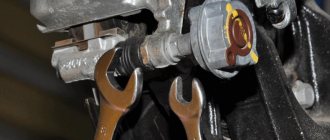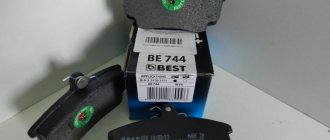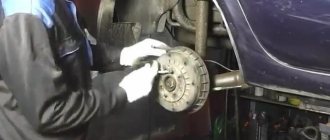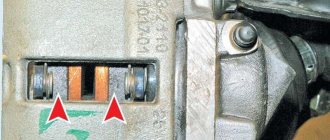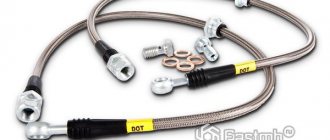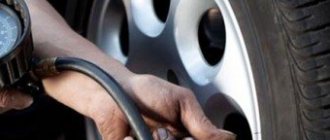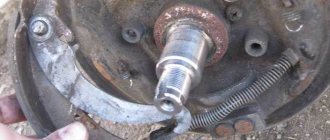After how long to change brake pads on Grant
Replacement of front and rear brake pads from Lada Granta
Front and rear brake
Of course, the columns can be operated up to a thickness of two or more than 1.5 mm, which is a smaller value (the value of two 1.5 mm is similar to the front and rear brake pads).
With the lowest Granta Lada
, it is likely that the rubber o-rings installed on the pistons come out of the sealing field located in the cylinder cavity in the brake mechanism.
Relieving pressure in the seal will cause brake water to leak into the external environment and lead to breakdown and ineffective operation of the vehicle's brakes. If you want to replace old gaskets with new ones, replace them without waiting for 1.5 mm of wear. It is enough to replace 5.7mm. There is a fact that when working for a long time in the limiting position of the piston, the earlier working surfaces of the seal usually become clogged with deposits, which will not allow the pistons to return to their original working position in the brake cylinder to the corresponding position under the thickness of the new one. brake pads .
When replacing pads, replace them only as a set on both sides. This will avoid differences in grip when braking and, accordingly, when moving the car to the side. To replace the front pads of Grant Lada
you will need: a flat-blade screwdriver, a chisel, a hammer, two wrenches and a 17" wrench
Replacing Lada Grant front brake pads
1. If your vehicle has brake pads, disconnect the negative cable from the battery. If this option is not available, you do not need to disconnect the battery. 2. Since the machine does not have front wheels or wheels, please install it securely on a vertical surface. Block the rear wheels using the handbrake and traction. 3. Check the brake fluid level. If the brake fluid gets close to the brake reservoir filler neck, pump out some of the fluid. 4. Bending with a screwdriver or chisel, using pliers, bending the edge of the bottom bolt lock washer (as shown in the photo)
5. Remove the bottom bracket mounting bolt. Hold the guide pin with the hex wrench. (as shown in the photo)
6. Now the bracket body can be rotated around the axis of the upper guide bolt.
Remove the pads from both sides of the brake disc. If the pads are pinched by the brake pistons, insert a screwdriver between the pads and the disc and pull the pistons back. The disc formed as a result of disc development can also prevent the spacers from being removed. In this case, you can use an angle grinder to remove the edges on the edge of the disc. If you have gaskets with wear indicators, disconnect the cable that fits them.
The gaskets can be removed. 7. After you have removed the old pad
, clean all brake parts from dirt and deposits, check for damage to the piston boots and leaks into the brake fluid. 8. Now, if you have sharpened the pad removal side, you should remove it all the way around the brake rotor. You can carefully sand the side using the same sander. When sanding a brake rotor in situ with a grinder, it is very easy to remove more thickness than necessary, be careful. Removing the brake disc will allow for easier and more convenient grinding of the rim, and the removed brake disc can be mounted on a lathe (ideally) and a minimum layer removed to restore the parallelism of the surfaces of the brake disc (the minimum size between surfaces should be at least 17.8 mm)
brakes Retightening front, rear, replacement time.
when is the change
front and rear
brake pads
, uneven pad wear; if necessary,
change the overlay
.
(The photo above shows a rim that has formed during wear, this rim not only prevents effective braking due to the disc not fitting the surfaces exactly, but can also squeak as it rubs against the guides on the blocks. Paper wear can be seen in the photo)
. it is much more convenient to sand the side using a sander with the disc removed
9. When installing new blocks, you will need to pour the piston into the cylinder. To do this, lower the cylinder body into place, take a screwdriver or knot and carefully press the piston inward against the disc. You can also use large pliers (the cylinder body must be lifted).
During this operation, make sure that brake fluid does not flow through the neck of the brake fluid reservoir located in the engine compartment onto the brake master cylinder. If the piston doesn't move or doesn't move well, you can unscrew the drain fitting to allow brake fluid to seep through slightly. In this case, the piston will be much easier to install in place. Be sure to replace the fluid leak nozzle and tighten it after installing the gasket. If in this case the piston does not move, it will be necessary to replace the brake mechanism with a new one. 10 After installing the new pads, lower the bracket, lower the cylinder, tighten the lower bolt and secure it with a lock washer to loosen it. Press the brake pedal several times to adjust the clearance. Replace the wheel. Check the brake fluid level in the tank.
Replacing rear brake pads Lada Grant
To replace the rear linings on a Lada Grant you will need: a screwdriver, pliers, a hammer, a whetstone, a 7 or 12 mm wrench (for guide pins holding the brake drum, the size depends on the type of fastening), 2 fasteners
Place the car on a vertical surface. Release the parking brake completely. Place the transfer in INC. Place a wheel chock under the front wheels. Remove the wheel from the side where you want to replace the rear brake pads.
1. Remove the brake drum by unscrewing the two studs
and beat evenly by tapping the drum on the back of the rim.
2. Remove the top spring by pulling it out with a screwdriver or pliers
and similar to the bottom screed.
3. Remove the front and rear block guide springs.
The rear shoe also has a handbrake lever with handbrake. The lever will need to be disconnected from the brake cable loop.
How much does it cost to replace brake pads?
5 Remove the pin and washer while holding the pin at the back of the shoe. Remove your pin and remove the lever from the rear brake pad.
6 Rear mounting brake pads
On a Lada Grant car, this is done in the reverse order. When installing the rear pads, make sure they fit into the guide holes on the brake cylinders. 7. To make it easier to reduce the piston, you can unscrew the drain fitting, and the movement of the pistons in the brake mechanism will be much easier. The gaskets can be connected with two mounting knives, as shown in the photo.
After installing the brake drum, tighten the valve and install the wheel.
When replacing the front and rear pads on a Lada Grant, it is strictly forbidden to press the brake pedal when the brake pistons do not rest on the installed pads and on the rear wheels when the brake drum is not installed. Otherwise, the pistons will be pushed out of the mechanisms, the system will leak, the mechanisms will work correctly, and the air ducts will not be ventilated.
Principle of operation
In order to talk sensibly about how long the pads last and after what mileage they need to be changed, it is worth asking the question: how the brake system works and what factors influence the service life of the brake pads.
In fact, the braking system of a car that is not equipped with a large number of safety and stabilization systems is designed quite primitively. By the way, even the number of components and functional units is also reduced to a minimum here.
The brake pedal has a spring mechanism that is connected to a vacuum or electric brake booster through a pipe system. This device works due to the ability of air to become rarefied and change its pressure, and its task is to multiply the force applied to the pedal. This not only takes the load off the driver, but also makes life easier for all the mechanisms whose operation lasts for more than one year.
Through the vacuum brake booster, pressure is supplied to the main brake cylinder, which is usually enough for normal operation of the brake system on any passenger car. It is a small metal cylinder with brake fluid pipes going out and going into it. Its task is to change the braking force between the wheels so that the braking is as uniform as possible. This allows you to achieve good controllability when braking and avoid various types of skidding.
It should be noted that brake pads, which usually last for 30–50 thousand kilometers, are fixed in calipers, which are some kind of fastenings. Being in such fastenings, the block does not play, and therefore the service interval is currently a fairly impressive number. How long does the caliper last? The answer to this question is quite complicated: it all depends on the make and model of the car. It is still possible to say how long a caliper lasts on a typical foreign car: usually its service life is at least 100 thousand kilometers.
Selecting brake pads for Lada “Grant”
The front pads for the Lada “Granta” consist of two parts: a plate and a friction lining applied to it. The rigidity, wear resistance and coefficient of friction of the pads, which depend on the quality of the friction material, are the most important parameters that determine their quality. Original pads recommended by the manufacturer are more reliable, durable and efficient. They are produced without the addition of asbestos, which poses an environmental hazard. Their only drawback is the price. Non-original pads are installed for the sake of economy, when they try to find something of acceptable quality for a reasonable price. Sometimes this is successful, sometimes such savings result in losses. For example, a low-quality lining that comes off during braking can cause the car to suddenly pull to the side and, as a result, an accident.
What is needed to replace the front pads
To replace the pads you will need:
- wheel wrench;
- jack;
- key to 13;
- key to 17;
- a powerful flat-head screwdriver or clamp;
- pliers;
- hammer;
- rubber bulb or syringe;
- chisel;
- set of new pads.
Attention: the front pads must be replaced only immediately, as a set (two on each side).
New pads: comparison with old ones
The condition of old and new components is best conveyed using a photograph, where wear, changes in the thickness and contour of the element are clearly visible.
Wear on the brake part of the old pad leads to the formation of severe wear on the brake disc (every vehicle owner faces this problem).
Worn brake pads significantly increase the load on the discs, which soon crack. That is why replacing elements on a Grant, even with your own hands, will protect the brake discs and increase comfort while driving a car.
Possible causes of pad defects
If during braking the driver hears a sharp squeak even after replacing the pads, the cause of the problem is the poor quality of the fractional layer. At the first contact, it crumbles, negatively affecting the work with the brake discs. This problem often occurs on original parts of cars such as VAZ 2110 and Lada Kalina.
It happens that the driver installed new front parts of the brake system, but from the first days the squeak does not go away. Sometimes a certain amount of time must pass for the grinding process to occur. The plaque that is inherent in the pads forms during production and creates a squeak that disappears after several thousand kilometers.
Next, you should highlight the wear of the strips. On one side, the friction layer may be completely worn out, which leads to friction between the disc and the metal base of the element. On the other hand, the fault may be poor-quality fastening of the wear sensor. After installing new parts, the owner of a Lada Granta may observe a whistle at the slightest contact of the pads with the discs.
Note! Weather conditions also affect the performance of front brake pads. In autumn, increased air humidity causes an unpleasant sound when starting the brake system. In the winter season, condensation, which forms due to strong temperature changes, creates the same effect as high humidity. Severe frosts create a coating on the surface of the pads, which, after heating the disc, turns into condensation.
Sometimes the problem may not be with the pads, but with the brake system itself. Vibrations that cause a feeling of worn-out elements are created when certain mechanisms of the system malfunction. If after replacing the elements the unpleasant sounds do not disappear, you should contact a specialist to diagnose the brake system.
How to choose and which ones are better to buy brake pads for Granta
The supply of brake system elements for Grant is carried out by. Specialization: trucks and cars. Since the end of 2012, JSC TIIR has been supplying front overlays made of composite material (1118-3501090). The peculiarity of the components is the absence of anti-creaking plates in the design. A special mastic is applied to the back side to suppress noise, vibrations, and squeaks.
The technology showed a number of shortcomings and in 2013 TIIR supplied new pads under the index (2192-3501090-10). They are also made of composite material under the number TIIR-299. Anti-squeak plates “Nulok” for Lada Granta are installed on the outside. The rear circuit is equipped with disc-type pads (21920-3502090-10). Components are also supplied by JSC TIIR. The number of the composite material TIIR is 444.
Make it a rule to block the rear wheels with the handbrake during any work on a car with the wheels removed. Make sure the handbrake is always tightened! It wouldn’t hurt to install wheel chocks, or boards, or a dumbbell (I have one) under the rear wheels.
Stop the other wheel with a block
- Remove the negative terminal from the battery.
- “Tear off” (loosen) the wheel bolts.
- Raise the car on a jack.
Search
Front and rear replacement brake pads for Granta Lada
The front and rear brake pads can be operated to a thickness of more than 1.5mm, which is a smaller value (a value of more than 1.5mm is the same as the front and rear pads). With the lowest Granta Lada , it is likely that the rubber o-rings installed on the pistons come out of the sealing field located in the cylinder cavity in the brake mechanism. Relieving pressure in the seal will cause brake water to leak into the external environment and lead to breakdown and ineffective operation of the vehicle's brakes.
To ensure that old pads are replaced with new ones, replace them with 1.5mm wear. It is enough to replace 5.7 mm. The fact is that during prolonged operation in the extreme position of the piston, the previously working sealing surfaces may become clogged with deposits, which will not allow the piston to return to its original working position in the brake cylinder to a position corresponding to the thickness. from new brake pads.
Cylinder replacement
I also decided to replace the working cylinder, since brake fluid was leaking from it. In order not to disassemble it again later, it is better to replace it immediately. Moreover, the brake pipe and the cylinder itself unscrewed easily.
I bought a new cylinder (more precisely, 2 at once - for the other side).
The main thing is that the tube unscrews, and the mounting bolts can be broken. New ones will still be installed. To prevent liquid from flowing from the tube, you can put a rubber cap on it, which is installed on the new cylinder.
Now you need to thoroughly clean everything from rust with a wire brush. When installing a new brake cylinder, I recommend lubricating the bolt threads with graphite. Next, insert the tube and loosen the bypass valve. The liquid will flow by gravity and fill the working cavity. When it starts to come out of the valve, you can tighten it.
Are the wheels different on different models and modifications of the Lada Granta?
The brake discs on different modifications of the Grant differ only in size. All of them are ventilated:
| R13 | R14 | R15 | |
| Where are they located? | "Kalina", "Granta" with an eight-valve engine | “Priora”, “Kalina” (eight- and sixteen-valve engines), “Lada Granta” and “Granta Liftback” - only for sixteen-valve engines | "Granta Sport" and "Kalina Sport" |
| Peculiarities | Less anther | Same size as boot | Installed only on sports versions of cars |
| Width | 250 mm | 280 mm | 380 mm |
| Acceptable wheel size | R13 and more | R14 and more | R15 and more |
If you want to upgrade your car's brakes, you can replace R13 with R14. The main thing is that the rims are no smaller than R14. This is practiced by those who are not satisfied with the stock Grant brakes. After modification, users experience a significant improvement in braking quality.
If such a replacement does not suit you, take a closer look at new brake discs from foreign cars. They will fit perfectly, no modifications will need to be made. Those who made such a replacement were satisfied.
What happens if you don't replace the disks on time?
The brake discs on the Grant must be changed in a timely manner. If you do not change it and drive on a heavily worn brake, the part may crack because it is very thin. The pistons may jam. On worn disks, they extend to the maximum depth, and there is a risk of distortion. Cooling will deteriorate significantly and the brakes will be constantly overheated.
Replacing brake system consumables is as important a procedure as updating the engine oil. This won’t take much of your time, but it can save your life in an emergency.
Reviews from car owners about brake pads
TCs are presented in a wide range on the market; for almost any car model you can purchase parts from various companies in auto stores. But not all pads are liked by users, and accordingly, reviews of spare parts are different.
The most popular products on the Russian market are Lucas/TRW; the company has been known in Russia for a long time; Lucas parts appeared on the domestic market back in the 90s. Of the positive qualities of the pads, car owners note:
- relatively low price;
- high wear resistance of linings;
- smooth braking.
There are also negative aspects of Lucas/TRW products:
- squeaking sound when pressing the brake pedal;
- reduced braking efficiency in wet weather.
Many people like ATE brake pads; among the advantages of the parts, car owners note:
- noiselessness and softness of braking;
- good contact with the brake disc.
The main disadvantage of ATE is that the pads generate a lot of dust and the discs quickly turn black. On many more copies, the linings wear out quite quickly, so the “consumables” have to be changed more often than they should be.
Brembo brake pads are reasonably priced; on a five-point scale, many car owners rated this company's products at 4 and 5 points. Brembo drivers note:
- high braking efficiency;
- noiselessness, the pads rarely squeak;
- good wear resistance.
To their chagrin, motorists note that recently the price of Brembo has been rising, and sometimes there are fakes - these pads are already characterized by low quality. Car owners do not have clear opinions about brake pads; each driver has his own preferences.
Related articles:
Rear pad service life
The braking system is designed in such a way that most of the load during braking is transferred to the front of the car - to the front pads. Based on this, the rear brake pads last a very long time. No specialist from a car dealership can tell you exactly how long a rear brake pad will last, but all because the following factors have a huge impact on its service life:
- driving style - a fast way of driving, where the driver constantly accelerates and brakes, will accelerate the wear of the pads;
- brake drum quality;
- other circumstances - for example, products that are used to sprinkle the road surface in winter have a destructive effect on friction linings.
If the operating conditions are favorable, then the rear block of the Lada Grant can last up to 60,000 km. However, when replacing a pad, you should focus on the condition of the lining, and not the total mileage of the car after installing the new pad. Pay attention to the thickness of the overlay. If it has worn down to 1.5 mm or has become even thinner or, much worse, has begun to peel off from the metal or chips and cracks have appeared, you need to urgently replace the rear pad of the Lada Grant to avoid unpleasant consequences.
When the lining has worn off and become smaller than 0.15 cm, the piston may leave the cylinder, resulting in brake fluid leakage and brake pad breakage.
Urgency
Now it’s time to answer the main question: how long do brake pads last on a car and when should they be changed? What affects their wear and the maximum mileage that is possible for a car without maintenance?
One of the fundamental factors that affects how long a car runs on the same brake pads is driving style. It's no secret that exactly how the braking is done and how often the driver has to press the pedal directly affects the service life of the brake pads and how long they last from replacement to replacement.
Obviously, the less often you have to brake, the longer the service life of the brake pads and the longer they last. However, we should not forget that the force that the pads exert on the disc has a very significant effect on the service life of a particular consumable. In this regard, to save money, it is recommended to brake as smoothly as possible and only at those moments when it is really necessary. It is worth noting that the difference in how long the pads travel with a calm and aggressive driving style is significant, and in some cases it reaches an impressive 35–40%.
Also, the quality of the consumable itself has a strong influence on how long the pads last on the car and the service mileage. It has long been known that, in order to save money, in the production of the most inexpensive pads, materials are used that not only wear out quickly, even if the driving style has always remained quite smooth, but also have weak adhesion properties. There is no need to remind once again that such a short service life of brake pads directly affects the safety of the driver and passengers, and it is especially important to understand this for owners of cars with high mileage, the wear of which is significant.
